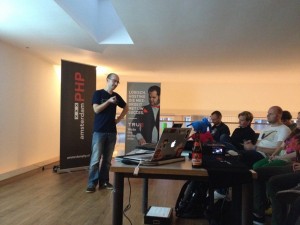PHP - The Future of Packages
Recently I tweeted about phpclasses.org. It was not such a friendly statement:
Why does phpclasses.org still exist? Most of the “packages” contain dangerous, stupid or useless code.
Manuel Lemos, the man behind PHP Classes, made me pull back a bit by pointing out that I was generalizing and that they do what they can to encourage people to do a good job. I recognize their effort. And of course, there is also good code on phpclasses.org.
Symfony2: Add a global option to console commands and generate a PID file
Recently I read the book Signaling PHP by Cal Evans. It’s a short book, yet very affordable and it learned me a couple of things. First of all it explains about how you can “capture” a Ctrl+C on your long-running command and do some necessary cleanup work before actually terminating the application. In the appendix it also mentioned the interesting concept of a PID file. Such a file is used to store a single process identifier. The file is created by the process itself, to allow other scripts or applications to terminate it. This is especially useful in the context of daemon applications. They can be started by some wrapper script, run in the background, then be monitored and eventually interrupted by an administrator using the SIGINT signal.
Symfony2: Some things I don't like about Bundles
This article could have been titled “Ten things I hate about bundles”, but that would be too harsh. The things I am going to describe, are not things I hate, but things I don’t like. Besides, when I count them, I don’t come to ten things…
Bundle extension discovery
A Symfony2 bundle can have an Extension class, which allows you to load service definitions from configuration files or define services for the application in a more dynamic way. From the Symfony documentation:
Looking back at the release of "A Year With Symfony"
A couple of weeks ago the reader count of my first book A Year With Symfony reached the number 365. It seemed to me an appropriate moment to write something about my experiences. In this post, I will not be too humble, and just cite some people who wrote some very nice things about my book on Twitter.
The book was highly anticipated ever since I first wrote something about it on Twitter. Leanpub book pages have a nice feature where users can subscribe to news about the book release.
Symfony2: Console Commands as Services - Why?
As you may have read on the Symfony blog: as of Symfony 2.4 you can register console commands using the service tag console.command.
What is the big deal, you would say. Well, let’s discover it now. This is how the documentation tells you to write your console commands:
namespace Matthias\ConsoleBundle\Command;
use Symfony\Bundle\FrameworkBundle\Command\ContainerAwareCommand;
use Symfony\Component\Console\Input\InputInterface;
use Symfony\Component\Console\Output\OutputInterface;
class MyCommand extends ContainerAwareCommand
{
protected function configure()
{
$this->setName('my:action');
}
protected function execute(InputInterface $input, OutputInterface $output)
{
// do something
}
}
How to make sure your command will be noticed?
Until Symfony 2.4 there were two requirements for your command to be picked up by the console application itself:
Principles of PHP Package Design

Yesterday I presented “Principles of PHP Package Design” at the monthly meetup of the AmsterdamPHP usergroup. This was quite an experimental presentation. I had prepared it on the same day actually, though I had been gathering the contents of it for several weeks.
Package design is a subject I’m very much interested in and you can be sure to hear more from me about it. Actually, I started writing a book about it! If you’re interested too, sign up on leanpub.com/principles-of-php-package-design.
Symfony2 & TDD: Testing a Configuration Class
Some of you may already know: I am a big fan of TDD - the real TDD, where you start with a failing test, and only write production code to make that specific test pass (there are three rules concerning this actually).
The TDD approach usually works pretty well for most classes in a project. But there are also classes which are somewhat difficult to test, like your bundle’s extension class, or its configuration class. The usual approach is to skip these classes, or to test them only using integration tests, when they are used in the context of a running application. This means you won’t have all the advantages of unit tests for these “units of code”. Some of the execution paths of the code in these classes may never be executed in a test environment, so errors will be reported when the code is running in production already.
Official book presentation: A Year With Symfony
After working on my book “A Year With Symfony” for four months, I published it yesterday at the Dutch Symfony Usergroup meetup in Amsterdam. It was really great to be able to do this real-time while everybody in the room was looking at the screen waiting for the build process to finish.
The book is hosted on Leanpub, which is a great platform for writing and publishing books. They provide the entire infrastructure. You get a good-looking landing page and they handle all things related to payment.
Why Symfony? Seven Facts
A couple of days ago I was asked to explain myself: “Why Symfony?”. I was reminded of this video - an interview with Fabien Potencier:
Fabien mentions some facts about Symfony that are key to understanding it, as an outsider. These same facts (and some more) will also help you to “sell” Symfony to others.
A New Book About Symfony2: A Year With Symfony
As you may have heard, I’m working on a book for Symfony2 developers. Besides The Book, which is the user documentation for building Symfony applications, some book-like websites and just a few e-books, there are currently no books for intermediate or advanced Symfony developers. My new book, called A Year With Symfony is exactly that.
If you have been reading the documentation and maybe some blog posts, you will want to know how you can get one step further. You wonder how you could structure your application, for it to be maintainable for more than a month. You ask yourself what it would take to write good bundles, which guidelines you and your team should define and follow. You may also question the built-in security measurements and you or your manager would like to know what needs to built on top of them to make a real secure application. A Year With Symfony will help you find an answer to all these questions.
